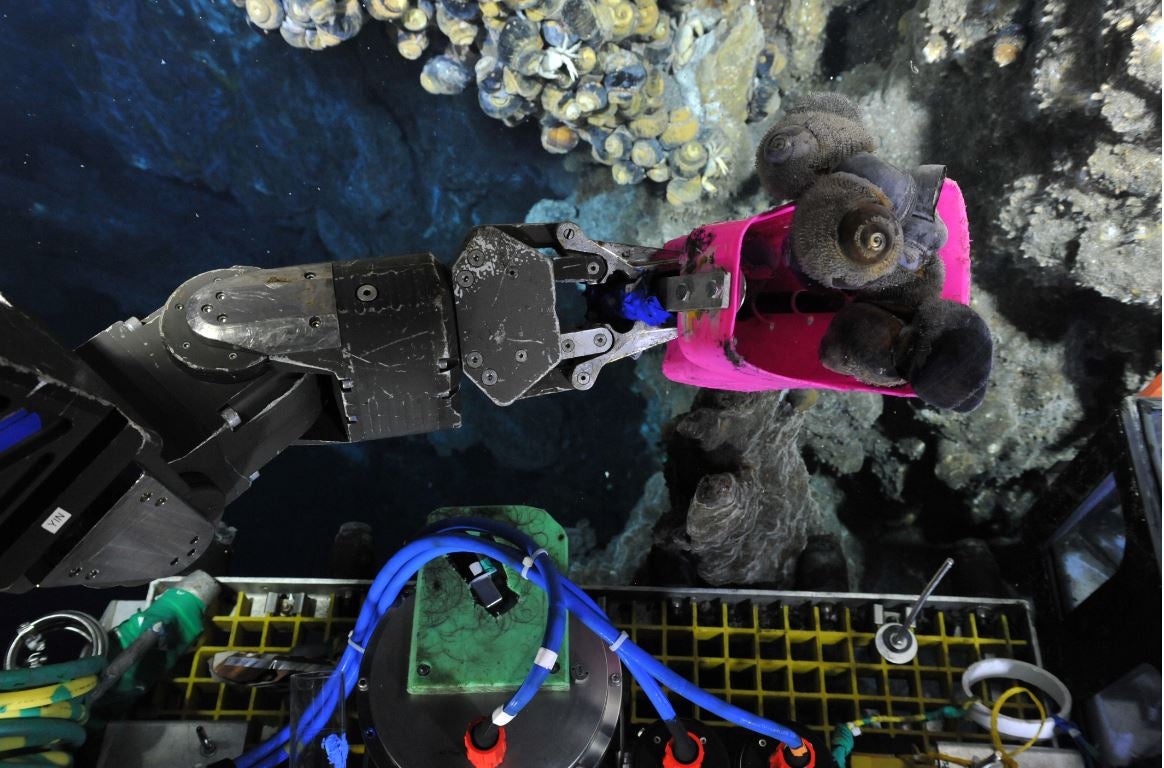You may have ridden out the pandemic in compact living quarters without, say, much natural light or air conditioning. Perhaps you lived with roommates or family in an atmosphere that, as time wore on, grew increasingly toxic.
Things could be worse! You could be a member of the Alviniconcha species—specifically, a small, spike-studded snail who thrives in an environment inhospitable to most aquatic life; mere meters from deep-sea hydrothermal vents that constantly spew toxic chemicals into the water. Think you have limited natural light? Try living nearly 10,000 feet below the surface of the ocean, where complete darkness envelops you 24 hours a day, under pressure so intense all the air pockets in your body would instantly collapse.
And forget Seamless. Forget food—at least the kind you ingest with your mouth. Your survival hinges on bacteria living in your gills (you have gills!) in a symbiotic relationship that provides you with energy, via a process called chemosynthesis. It’s like photosynthesis, but chemosynthesis is driven by chemical reactions instead of light. As there’s no sunlight and minimal oxygen present, the bacteria that dwell within Alviniconcha use hydrogen and sulfur molecules to produce sugars and other macronutrients that the animals then use as food. “There’s very little food so deep in the ocean,” says Dr. Corinna Breusing, postdoctoral researcher at the University of Rhode Island and co-author of a recent paper on the snails and their symbionts. “Having your own food-producing machine is much better than waiting for it to fall to you.” While chemosynthesis is common around hydrothermal vents, it can occur in places outside of vents, such as in cold seeps and whale falls and even salt marshes: anyplace the proper mélange of inorganic compounds is brewing.
The researchers studied Alviniconcha living at the bottom of the Lau Basin, in the southwestern Pacific Ocean, and found that the type of bacterial symbiont determined where their particular host species could live. “The symbionts have different metabolic capacities and adaptations, so we think that the symbionts influence the distribution of the animal,” Breusing says, adding that snails with Campylobacteria dominated at vents with higher concentrations of sulfide and hydrogen, while those with Gammaproteobacteria were able to thrive at sites with lower concentrations of sulfide and hydrogen. Meaning: your chef-roommate, who happens to live in your respiratory system, also decides where you hang your hat (so to speak).
“There’s very little food deep in the ocean, so having your own food-producing machine is much better than waiting for it to fall to you.”
When Alviniconcha are free-wheeling larvae, they still have digestive tracts and mostly feed on plankton. At some stage in early development, Breusing says, the snails take up bacteria from the environment in a process called horizontal transmission. “We don’t know a lot about the exact infection process, but they probably invade the gill cells of the animal,” she says. Once the snails become sessile, they lose the ability to digest food and the bacteria swing into action. Having a live-in roommate might be a drag, but there are upsides to it, too.

Part of what makes this research—and similar studies, like this one on deep sea anemones, whose symbionts churn out chemosynthetically derived sustenance at a stunning 12,000 feet below sea level—so remarkable is how logistically challenging it is, says Breusing. To study these snails, you need both a research vessel and a robot to collect the snails, and then the experiments need to be done under terrific atmospheric pressure. In order to mimic the extreme conditions on the margins of these hydrothermal vents, the researchers collected Alviniconcha during a 2016 expedition aboard Schmidt Ocean Institute’s R/V Falkor expedition using a remotely operated vehicle (ROV). After bringing the Alviniconcha to the surface, they put them in high-pressure tanks, where the team let the animals acclimate for a day or so before studying them.
Most hydrothermal vent-dwelling animals, such the aforementioned snails and deep-sea anemones, as well as some species of mussels and tube worms, depend on bacteria that they pick up from the environment, but there is a species of deep-sea clam that passes their symbiont down from mother to offspring, like a fancy set of dinner plates. (This is rare in the marine world, Breusing says.) In the case of the deep-sea clams, where the symbiont is inherited, the symbiont cannot thrive outside the host and dies with it. But if a symbiont is taken up from the environment, it can be released back into the environment after its host dies, ready to help feed a brand-new host.
Alviniconcha might not pack the same visual punch as much marine life does much closer to the surface, but their very existence points to the origins of life on Earth. Before oxygen was free and plentiful, microbial life had to work with inorganic compounds like methane and ammonia, which over millennia dissolved into the seas. Much is still murky about how these little snails co-evolved with the bacteria that enable them to survive, but these fascinating ecosystems indicate that our education about life at the margins is just getting started.
Lead image: Alvinichoncha competing for position by a hydrothermal vent in the Lau Basin. Credit: Schmidt Ocean Institute / ROV ROPOS































